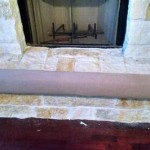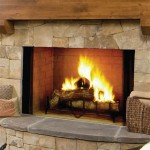Fireplace Refractory Panels Replacement: A Comprehensive Guide
Fireplace refractory panels, also known as firebricks or fireboards, are essential components of a fireplace or wood-burning stove. Their primary function is to protect the firebox, the interior chamber where combustion occurs, from the intense heat generated by burning wood or other fuel. These panels are specifically designed to withstand extremely high temperatures without cracking, warping, or deteriorating. Over time, however, even the most durable refractory panels will succumb to the constant thermal stress, leading to the need for replacement.
Understanding the importance of refractory panels, recognizing the signs of deterioration, and knowing how to replace them are crucial for maintaining the safety and efficiency of a fireplace. Ignoring damaged or failing refractory panels can lead to serious problems, including firebox damage, reduced heating efficiency, and even increased fire risk.
This article provides a detailed guide to fireplace refractory panel replacement, covering the functions of these panels, identifying signs of wear and tear, outlining the replacement process, and offering valuable tips for selecting the right panels and ensuring proper installation. It aims to empower homeowners with the knowledge necessary to maintain their fireplaces safely and effectively.
Understanding the Function of Fireplace Refractory Panels
Refractory panels are more than just aesthetically pleasing additions to a fireplace; they perform several critical functions that contribute to the overall safety and efficiency of the heating appliance.
The most important function of refractory panels is thermal protection. The panels are designed to absorb and reflect heat, preventing it from reaching the firebox walls and potentially damaging the surrounding structure. Fireboxes are typically constructed from metal, which, while durable, is susceptible to warping, cracking, and even melting under prolonged exposure to intense heat. Refractory panels act as a thermal barrier, extending the lifespan of the firebox and preventing costly repairs.
Refractory panels also contribute to improved heating efficiency. By reflecting heat back into the firebox, the panels help to maintain a higher combustion temperature. This more complete combustion results in less unburned fuel, reducing emissions of smoke and creosote, and maximizing the heat output of the fireplace. A fireplace with intact and properly functioning refractory panels will produce more heat using less fuel, ultimately saving money on heating costs.
Furthermore, refractory panels play a crucial role in protecting the structural integrity of the fireplace. The extreme temperature fluctuations within the firebox can cause stress and weaken the metal components. By absorbing and dissipating heat, the panels minimize these temperature fluctuations, reducing the strain on the firebox and preventing premature failure. This extends the overall lifespan of the fireplace and ensures its continued safe operation.
Finally, some refractory panels are designed to enhance the aesthetic appeal of the fireplace. They come in a variety of textures, colors, and patterns, allowing homeowners to customize the look of their fireplace and create a visually appealing focal point in their living space.
Identifying Signs of Deterioration and Damage
Regular inspection of the fireplace's refractory panels is essential for identifying signs of deterioration and preventing potential problems. Early detection allows for timely replacement, minimizing the risk of further damage and ensuring the continued safe operation of the fireplace. Here are some common indicators that refractory panels may need to be replaced:
Cracking is one of the most common signs of wear and tear. Hairline cracks may initially be insignificant, but over time, they can widen and deepen, compromising the panel's structural integrity and its ability to withstand high temperatures. Larger cracks can allow heat to penetrate the firebox walls, potentially causing damage. Any crack that is wider than a few millimeters should be considered a sign that replacement is necessary.
Spalling, which refers to the chipping, flaking, or crumbling of the panel surface, is another indicator of deterioration. Spalling occurs when the surface of the panel is exposed to repeated cycles of heating and cooling, causing it to weaken and break apart. This can significantly reduce the panel's effectiveness and increase the risk of heat damage to the firebox.
Warping, or bending of the refractory panels, indicates that they have been subjected to excessive heat or uneven pressure. Warping can compromise the panel's ability to fit snugly against the firebox walls, creating gaps that allow heat to escape and potentially damage the underlying structure. Severely warped panels should be replaced immediately.
Missing pieces are a clear indication that the refractory panels have been significantly damaged. Missing sections of the panel expose the firebox walls to direct heat, increasing the risk of warping, cracking, and other forms of damage. Any missing pieces should be replaced as soon as possible to prevent further deterioration.
Discoloration, such as dark spots or stains, may indicate that the panels are absorbing excessive moisture or that they have been exposed to corrosive substances. While discoloration alone may not always necessitate replacement, it is a sign that the panels are not functioning optimally and should be inspected more closely for other signs of damage.
When inspecting refractory panels, it's crucial to use a bright flashlight to examine the entire surface, paying close attention to corners, edges, and areas exposed to direct flame. Any signs of the damage described above should prompt immediate action to assess the extent of the problem and determine whether replacement is necessary.
The Refractory Panel Replacement Process
Replacing fireplace refractory panels is a relatively straightforward process that most homeowners can undertake with the right tools and a bit of patience. However, it's essential to prioritize safety and follow these steps carefully to ensure a successful and long-lasting repair. Prior to beginning any work, ensure the fireplace is completely cool and disconnected from any gas or electrical power sources.
The first step involves gathering the necessary tools and materials. This typically includes a screwdriver or nut driver (depending on the type of fasteners used to secure the panels), a putty knife or scraper (for removing old mortar or adhesive), a measuring tape, new refractory panels, mortar or high-temperature adhesive specifically designed for fireplace applications, safety glasses, and gloves.
Next, carefully remove the old refractory panels. Depending on the fireplace design, the panels may be held in place by screws, clips, or mortar. Identify the type of fasteners used and remove them accordingly. If the panels are mortared or glued in place, use a putty knife or scraper to gently loosen them from the firebox walls. Be careful not to damage the surrounding firebox structure during this process.
Once the old panels have been removed, thoroughly clean the firebox walls. Remove any remaining mortar, adhesive, soot, or debris. A wire brush or scraper may be helpful for removing stubborn residue. Ensure that the surface is clean, dry, and smooth to provide a good bonding surface for the new panels.
Measure the firebox walls to determine the exact size and shape of the new refractory panels needed. It's crucial to obtain accurate measurements to ensure that the new panels fit snugly against the walls and provide adequate protection. If necessary, the new panels can be cut to size using a masonry saw or grinder. Always wear safety glasses and a dust mask when cutting refractory panels.
Apply mortar or high-temperature adhesive to the back of the new refractory panels, following the manufacturer's instructions. Use a notched trowel to create even ridges in the adhesive, ensuring good contact with the firebox walls. Position the panels carefully against the walls, pressing them firmly into place. Use a level to ensure that the panels are aligned properly.
If necessary, use shims or spacers to hold the panels in place while the mortar or adhesive cures. Allow the mortar or adhesive to dry completely according to the manufacturer's instructions. This may take several hours or even overnight, depending on the product used.
Once the mortar or adhesive has fully cured, remove any shims or spacers. Inspect the installation carefully to ensure that all panels are securely in place and that there are no gaps or cracks. If necessary, apply additional mortar or adhesive to fill any gaps or cracks.
Finally, before using the fireplace, allow the new refractory panels to cure completely. This may involve a slow, controlled burn to gradually heat the panels and allow them to fully set. Consult the manufacturer's instructions for specific curing recommendations.
By following these steps carefully, homeowners can successfully replace their fireplace refractory panels and ensure the continued safe and efficient operation of their fireplaces. If the homeowner is unsure about any aspect of the process, seeking professional assistance from a qualified fireplace technician is recommended.
Selecting the Right Refractory Panels and Ensuring Proper Installation
Choosing the correct type of refractory panels and ensuring proper installation are crucial for achieving optimal performance and longevity.
When selecting refractory panels, carefully consider the specifications of the fireplace. This includes the size and shape of the firebox, the type of fuel burned (wood, gas, etc.), and the manufacturer's recommendations. Consult the fireplace's owner's manual or contact the manufacturer for specific guidance on the appropriate type of refractory panels to use.
Different types of refractory panels are available, each with its own unique properties and applications. Firebricks are typically made from dense, heat-resistant clay and are suitable for high-temperature applications. Refractory boards are lighter and easier to cut, but they may not be as durable as firebricks. Castable refractories are a type of cement-like material that can be molded into custom shapes, offering flexibility in design and installation.
The thickness of the refractory panels is another important consideration. Thicker panels provide greater thermal protection and are more durable, but they may also be more expensive and require more space within the firebox. Choose a panel thickness that is appropriate for the specific application and the anticipated heat output of the fireplace.
When installing refractory panels, it is essential to use the correct type of mortar or adhesive. Conventional mortar is not suitable for fireplace applications because it will not withstand the high temperatures. Use only mortar or adhesive specifically designed for fireplace refractory panels. These products are formulated to withstand extreme heat and provide a strong, durable bond.
Proper ventilation is also crucial for ensuring the longevity of refractory panels. Make sure that the fireplace has adequate ventilation to prevent overheating and the buildup of moisture. A blocked chimney or flue can restrict airflow and cause excessive heat to build up within the firebox, potentially damaging the refractory panels.
Regular maintenance is essential for extending the life of refractory panels. Clean the fireplace regularly to remove soot, ash, and creosote buildup. Inspect the panels periodically for signs of damage and make repairs as needed. Addressing minor problems early on can prevent more serious issues from developing.
Following these guidelines will help ensure that the right refractory panels are selected and installed correctly, maximizing their performance, extending their lifespan, and contributing to the safe and efficient operation of the fireplace.

Fireplace Refractory Panels Woodstoves Fireplaces

Universal Large Fireplace Replacement Stack Brick Refractory Panel

Fireplace Refractory Panels Woodstoves Fireplaces

Fc Refractory Panel Replacement

Ihp Refractory Panel Kit D41 Hc 42 And Rd Models

Repair Your Fireplace Or Firebox Refractory Panel Replacement Parging

What Causes Issues To Replace Fireplace Refractory Panels

Santa S Friend Chimney Servicetime To Replace Your Firebox Panels Jackson Ms

A Plus Inc Superior Br 42 Replacement Parts And Accessories

Pleasant Hearth Firebrick Panel Set For 36 In Zero Clearance Ventless Dual Fuel Fireplace Insert Zrp360 The Home Depot
Related Posts








